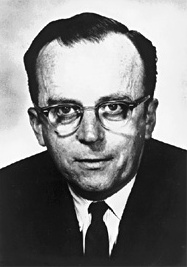
Back جوزيف ليكلايدر Arabic چوزيف ليكلايدر ARZ Joze Karl Robnet Liklayder Azerbaijani Джозэф Ліклайдэр Byelorussian J. C. R. Licklider Catalan Joseph Carl Robnett Licklider Czech J. C. R. Licklider German Joseph Carl Robnett Licklider Spanish جی.سی.آر. لیکلایدر Persian J. C. R. Licklider Finnish
Joseph Carl Robnett Licklider | |
|---|---|
 | |
| Born | March 11, 1915 St. Louis, Missouri, U.S. |
| Died | June 26, 1990 (aged 75) Arlington, Massachusetts, U.S. |
| Other names | J. C. R Lick "Computing's Johnny Appleseed" |
| Known for | Cybernetics/Interactive computing "Intergalactic Computer Network" (Internet) Artificial Intelligence Psychoacoustics |
| Spouse | Louise Carpenter |
| Children | 2 |
| Academic background | |
| Education | Washington University in St. Louis University of Rochester |
| Academic work | |
| Doctoral students | Dalbir Bindra[1] |
| Influenced | Jerome I. Elkind[2] |
Joseph Carl Robnett Licklider (/ˈlɪklaɪdər/; March 11, 1915 – June 26, 1990), known simply as J. C. R. or "Lick", was an American psychologist[3] and computer scientist who is considered to be among the most prominent figures in computer science development and general computing history.
He is particularly remembered for being one of the first to foresee modern-style interactive computing and its application to all manner of activities; and also as an Internet pioneer with an early vision of a worldwide computer network long before it was built. He did much to initiate this by funding research that led to significant advances in computing technology, including today's canonical graphical user interface, and the ARPANET, which is the direct predecessor of the Internet.
Robert Taylor, founder of Xerox PARC's Computer Science Laboratory and Digital Equipment Corporation's Systems Research Center, noted that "most of the significant advances in computer technology—including the work that my group did at Xerox PARC—were simply extrapolations of Lick's vision. They were not really new visions of their own. So he was really the father of it all".[4]
- ^ Melzack, Ronald (1 January 1982). "Dalbir Bindra: 1922-1980". The American Journal of Psychology. 95 (1): 161–163. JSTOR 1422665.
- ^ "Jerome I. Elkind '51, ScD '56". MIT Energy Initiative. MIT. Archived from the original on 4 February 2021. Retrieved 20 December 2016.
- ^ Miller, G. A. (1991), "J. C. R. Licklider, psychologist", Journal of the Acoustical Society of America 89, no. 4B, pp. 1887–1887
- ^ Waldrop, M. Mitchell (2001). The Dream Machine: J. C. R. Licklider and the Revolution That Made Computing Personal. New York: Viking Penguin. p. 470. ISBN 978-0-670-89976-0.